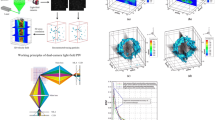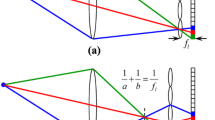Abstract
As a novel volumetric particle image velocimetry technique, single-camera light-field PIV (LF-PIV) is able to acquire three-dimensional flow fields through a single camera. Compared with other multi-camera 3D PIV techniques, LF-PIV has distinct advantages, including concise hardware setup and low optical access requirements. Its capability has proven effective in many experimental investigations. In this study, the use of LF-PIV in measuring a self-similar adverse pressure-gradient turbulent boundary layer (APG-TBL) is demonstrated. Experiments are performed in a large water tunnel at the Laboratory for Turbulence Research in Aerospace and Combustion (LTRAC), Monash University. Sets of 250 light-field PIV image pairs are captured covering both the inner and outer regions of the boundary layer. Instantaneous 3D velocity fields are reconstructed using a GPU accelerated density ray tracing multiplicative reconstruction technique (DRT-MART) and three-dimensional cross-correlation methods. The LF-PIV results are compared with two-dimensional PIV (2D-PIV) measurements of the same flow. Comparable accuracy to 2D-PIV is achieved for first- and second-order velocity statistics above approximately \( y/\delta_{1} = 1 \).
Graphic abstract









Similar content being viewed by others
References
Adrian RJ, Westerweel J (2011) Particle image velocimetry. Cambridge University Press, Cambridge
Atkinson C, Soria J (2009) An efficient simultaneous reconstruction technique for tomographic particle image velocimetry. Exp Fluids 47:553
Atkinson C, Buchner AJ, Kitsios V, Soria J (2015) A multi-camera PIV system for the study of self-similar APG turbulent boundary layers. In: 11th Int. Sym. on Particle Image Velocimetry -PIV15, September 14–16, Santa Barbara, California
Atkinson C, Buchner A-J, Sekimoto A, Kitsios V, Soria J (2016a) Experimental measurements of a self-similar adverse pressure gradient turbulent boundary layer. In: 20th Australasian Fluid Mechanics Conference, Perth, Australia
Atkinson C, Buchner A-J, Sekimoto A, Eisfelder M, Kitsios V, Soria J (2016b) Time-resolved piv measurements of a self-similar adverse pressure gradient turbulent boundary layer. In: The 18th international symposium on the application of laser and imaging techniques to fluid mechanics, Lisbon, Portugal
Belden J, Truscott TT, Axiak MC, Techet AH (2010) Three-dimensional synthetic aperture particle image velocimetry. Measure Sci Technol 21:125403
Bobke A, Vinuesa R, Örlü R, Schlatter P (2017) History effects and near equilibrium in adverse-pressure-gradient turbulent boundary layers. J Fluid Mech 820:667–692
Bolton JT, Thurow B, Arora N, Alvi F (2017) Single camera 3D measurement of a shock wave-turbulent boundary layer interaction. In: The 55th AIAA aerospace sciences meeting, Grapevine, Texas
Brucker C (1996) 3D scanning particle image velocimetry: technique and application to a spherical cap wake flow. Appl Sci Res 56:157–179
Buchner A-J, Lozano-Durán A, Kitsios V, Atkinson C, Soria J (2016) Local topology via the invariants of the velocity gradient tensor within vortex clusters and intense Reynolds stress structures in turbulent channel flow. J Phys Conf Ser 708:012005
Buchner A-J, Honnery D, Soria J (2017) Stability and three-dimensional evolution of a transitional dynamic stall vortex. J Fluid Mech 823:166–197
Chen H, Sick V (2017) Three-dimensional three-component air flow visualization in a steady-state engine flow bench using a plenoptic camera. SAE Int J Engines 10:625–635
Deem E, Zhang Y, Cattafesta L, Fahringer T, Thurow B (2016) On the resolution of plenoptic PIV. Measure Sci Technol 27:084003
Ding J, Wang J, Liu Y, Shi S (2015) Dense ray tracing based reconstruction algorithm for light-field volumetric particle image velocimetry. In: 7th australian conference on laser diagnostics in fluid mechanics and combustion, Melbourne, Australia
Ding J, Lim D, Sheikh S, Xu S, Shi S, New TH (2018) Volumetric measurement of a supersonic jet with single-camera light-field PIV. In: The 18th international symposium on the application of laser and imaging techniques to fluid mechanics, Lisbon, Portugal
Eisfelder M P, Müller J S, Sekimoto A, Buchner A-J, Kitsios V, Atkinson C, Oberleithner K, Soria J (2018) Stability of a self-similar adverse pressure gradient turbulent boundary layer. In: 21st Australasian fluid mechanics conference, Adelaide, Australia
Elsinga G, Scarano F, Wieneke B et al (2006) Tomographic particle image velocimetry. Exp Fluids 41:933–947
Fahringer T, Lynch K, Thurow B (2015) Volumetric particle image velocimetry with a single plenoptic camera. Measure Sci Technol 26:115201
Herman GT, Lent A (1976) Iterative reconstruction algorithms. Comput Biol Med 6:273–294
Hinsch K (2002) Holographic particle image velocimetry. Measure Sci Technol 13:R61–R72
Katz J, Sheng J (2010) Applications of holography in fluid mechanics and particle dynamics. Annu Rev Fluid Mech 42:531–555
Kitsios V, Atkinson C, Sillero JA, Borrell G, Gungor AG, Jiménez J, Soria J (2016) Direct numerical simulation of a self-similar adverse pressure gradient turbulent boundary layer. Int J Heat Fluid Flow 61:129–136
Kitsios V, Sekimoto A, Atkinson C, Sillero JA, Borrell G, Gungor AG, Jiménez J, Soria J (2017) Direct numerical simulation of a self-similar adverse pressure gradient turbulent boundary layer at the verge of separation. J Fluid Mech 829:392–419
Li H, Ding J, Zhao Z, Qu W, Xiong J, Shi S (2017) Investigation of 3D flow behaviour inside a 3 × 3 rod bundle using Light Field-PIV and the matched refractive index techniques. In: The 12th international symposium on particle image velocimetry. Busan, Korea
Pereira F, Gharib M, Dabiri D et al (2000) Defocusing digital particle image velocimetry: a 3-component 3-dimensional DPIV measurement technique. Application to bubbly flows. Exp Fluids [Suppl.]:S78–S84
Prasad AK, Adrian RJ (1993) Stereoscopic particle image velocimetry applied to liquid flows. Exp Fluids 15:49–60
Scarano F (2013) Tomographic PIV: principles and practice. Meas Sci Technol 24:1–28
Sheskin D (2000) Handbook of parametric and nonparametric statistical procedures, 2nd edn. Chapman and Hall/CRC, London
Shi S, Wang J, Ding J, Zhao Z, New TH (2016) Parametric study on light field volumetric particle image velocimetry. Flow Measure Instrum 49:70–88
Shi S, Ding J, New TH, Soria J (2017) Light-field camera-based 3D volumetric particle image velocimetry with dense ray tracing reconstruction technique. Exp Fluids 58:78
Shi S, Ding J, Atkinson C, Soria J, New TH (2018) A detailed comparison of single-camera light-field PIV and tomographic PIV. Exp Fluids 59:46
Shi S, Ding J, New TH, Liu Y, Zhang H (2019) Volumetric calibration enhancements for single-camera light-field PIV. Exp Fluids 60(1):21
Soria J (1996) An investigation of the near wake of a circular cylinder using a video-based digital cross-correlation particle image velocimetry technique. Exp Thermal Fluid Sci 12(2):221–233
Vila CS, Örlü R, Vinuesa R, Schlatter P, Ianiro A, Discetti S (2017) Adverse-pressure-gradient effects on turbulent boundary layers: statistics and flow-field organization. Flow Turbul Combust 99:589–612
Willert C, Gharib M (1992) Three-dimensional particle imaging with a single camera. Exp Fluids 12:353–358
Xu S, Ding J, Zhao Z, Atkinson C, Soria J, Shi S (2017) 3D flow measurements of circular air jet at Re = 30,000 using light field particle image velocimetry. In: The 12th international symposium on particle image velocimetry, Busan, Korea
Zhao Z, Buchner A-J, Ding J, Shi S, Atkinson C, Soria J (2018) Volumetric measurements of a self-similar adverse pressure gradient turbulent boundary layer using single-camera light-field particle image velocimetry. In: The 18th international symposium on the application of laser and imaging techniques to fluid mechanics, Lisbon, Portugal
Acknowledgements
Financial support provided by National Natural Science Foundation of China (Grant Nos. 11472175, 11772197).
Author information
Authors and Affiliations
Corresponding authors
Additional information
Publisher's Note
Springer Nature remains neutral with regard to jurisdictional claims in published maps and institutional affiliations.
Electronic supplementary material
Below is the link to the electronic supplementary material.
Rights and permissions
About this article
Cite this article
Zhao, Z., Buchner, AJ., Atkinson, C. et al. Volumetric measurements of a self-similar adverse pressure gradient turbulent boundary layer using single-camera light-field particle image velocimetry. Exp Fluids 60, 141 (2019). https://doi.org/10.1007/s00348-019-2788-0
Received:
Revised:
Accepted:
Published:
DOI: https://doi.org/10.1007/s00348-019-2788-0




